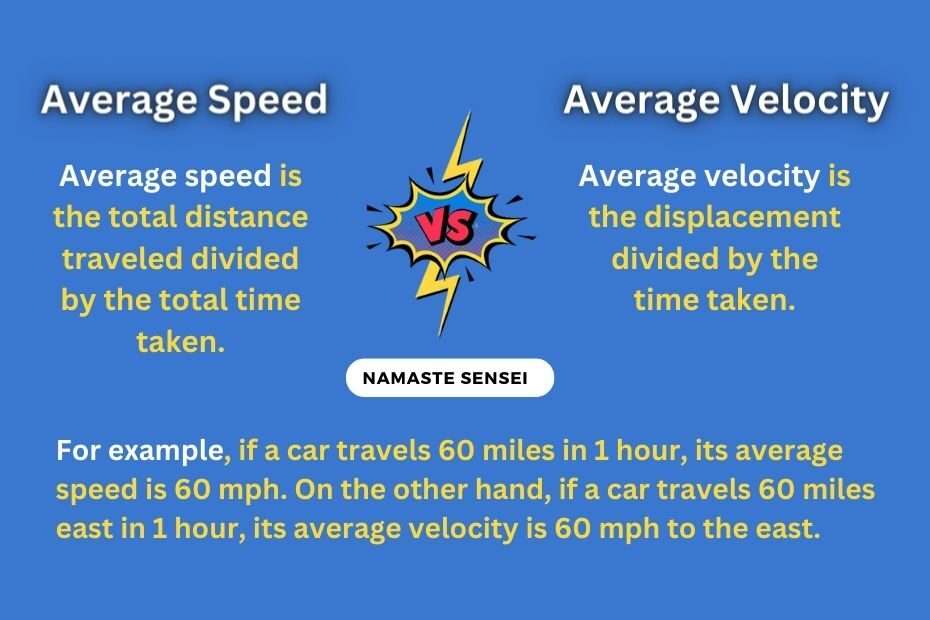Average Speed Vs Average Velocity
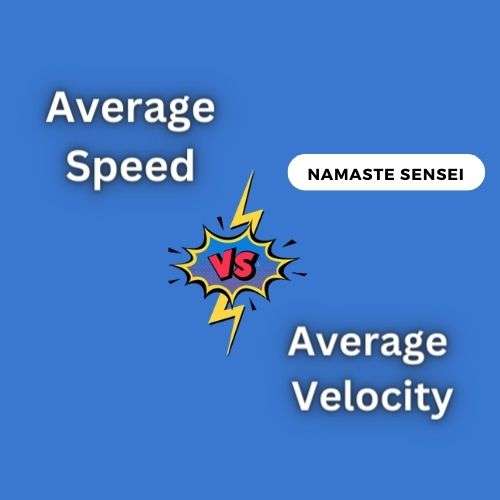
Do you know the difference between average speed and average velocity? When it comes to motion, it can be confusing to understand the average speed vs average velocity difference. Many people use the terms interchangeably, but they are two distinct concepts.
Average speed is the total distance traveled divided by the total time taken, while average velocity is the displacement divided by the time taken. In this blog post, we will discuss the difference between average speed and average velocity and how to calculate each of them. There will be no room for doubt left for you. So let’s start it.
5 Key Differences between average speed and average velocity with examples
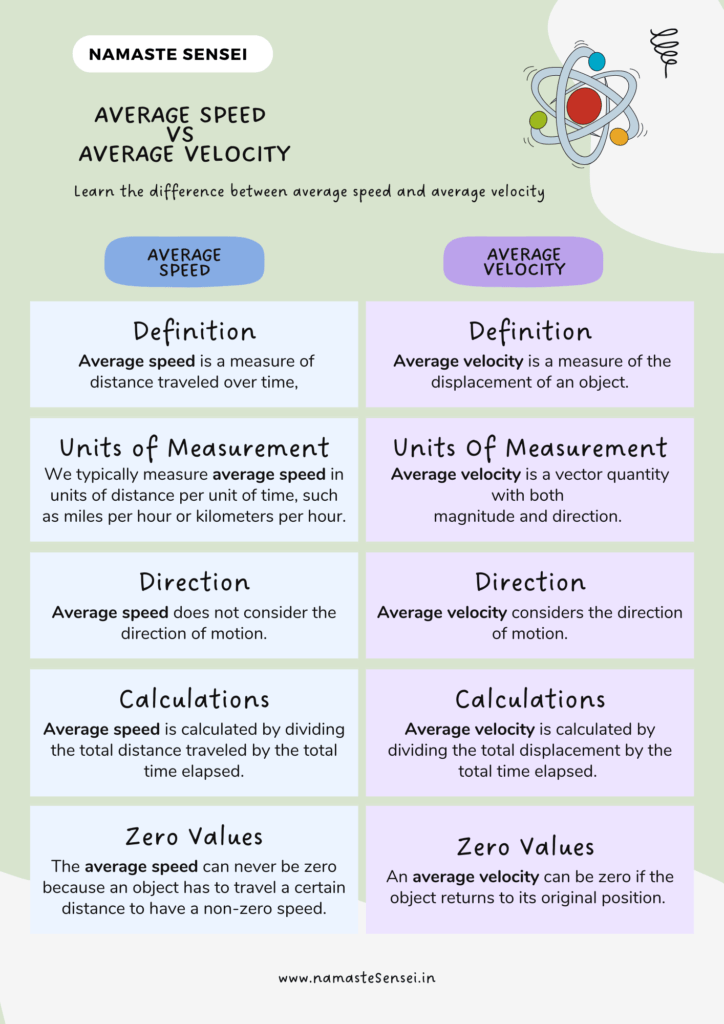
Below are the five key differences between average speed and average velocity.
-
DEFINITION (Average speed vs average velocity)
Average speed is a measure of distance traveled over time, while average velocity is a measure of the displacement of an object.
For example, if a car travels 60 miles in 1 hour, its average speed is 60 mph. On the other hand, if a car travels 60 miles east in 1 hour, its average velocity is 60 mph to the east.
|
Knowledge booster:
In short, distance measures how much ground an object has covered, while displacement measures the change in position of an object, regardless of the path taken. |
-
Units of measurement
We typically measure average speed in units of distance per unit of time, such as miles per hour or kilometers per hour, while average velocity is a vector quantity with both magnitude and direction.
For example, the average speed of a car on a highway is typically around 65-70 mph, while the average velocity of a car on a highway is typically around 65-70 mph in a particular direction.
-
Direction
Average speed does not consider the direction of motion, while average velocity does.
For example, if a car is traveling in a circular path, the average speed will be the same, but the average velocity will be zero, as it comes back to the starting point.
-
Calculations (Average speed and average velocity)
Average speed is calculated by dividing the total distance traveled by the total time elapsed, while average velocity is calculated by dividing the total displacement by the total time elapsed.
Note: Calculations for average speed vs average velocity are given below.
-
Zero values
Average speed can never be zero because an object has to travel a certain distance to have a non-zero speed, while average velocity can be zero if the object returns to its original position.
For example, if a person walks around in a circular path and comes back to the starting point, his average velocity is zero, but he has traveled a certain distance and thus his average speed is non-zero.
Similarities between average speed vs average velocity with examples
-
Both are measures of motion: Average speed and average velocity are both used to describe the motion of an object. They both provide information about how fast an object is moving and over what time.
For example, if a car travels 60 miles in 1 hour, its average speed is 60 mph, and we can also define its average velocity as 60 mph in a certain direction. -
Both use time as a variable: Both average speed and average velocity consider the time that an object has been in motion. They are calculated by dividing a distance or displacement by a time interval.
For example, if a car travels 60 miles in 1 hour, its average speed is 60 mph, while if the car travels 60 miles in 2 hours, its average speed is 30 mph. Note: We have given calculations separately below to make it understand better. -
Both can compare different motions: Both average speed and average velocity can compare the motion of different objects or the same object at different times.
For example, you can compare the average speed of a car and a bike, or the average velocity of a car going from point A to point B, and another car going from point A to point C -
Both are scalar and vector quantities: Both average speed and average velocity are scalar quantities in terms of magnitude, but average velocity is a vector quantity in terms of direction.
-
Both can determine the motion of an object in real-world scenarios: Both average speed and average velocity can determine the motion of an object in real-world scenarios, such as in transportation and sports.
For example, the average speed of a runner in a marathon, or the average velocity of a flying plane.
How to calculate average speed?
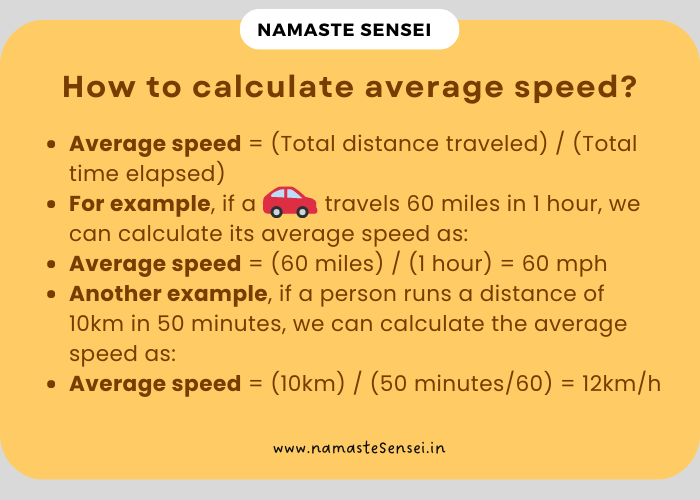
|
We can calculate average speed by dividing the total distance traveled by the total time elapsed.
In the abstract, to calculate average speed, you need to know the distance traveled and the time to travel that distance. Then divide the distance by the time to get the average speed. |
How to calculate the average velocity?
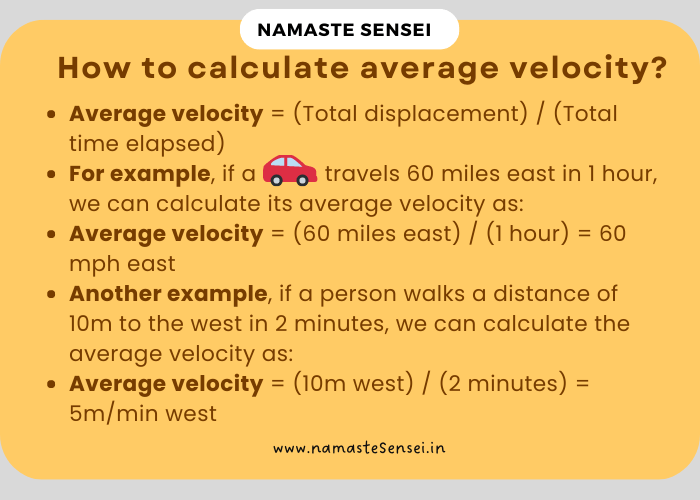
|
We can calculate the average velocity by dividing the total displacement by the total time elapsed. Displacement is the change in the position of an object and is a vector quantity, having both magnitude and direction.
In the abstract, to calculate average velocity, you need to know the displacement (change in position) and the time it took to travel that distance. Then divide the displacement by the time to get the average velocity. Remember, average velocity is a vector quantity, and thus it also has a direction component. |
Why average velocity is more useful than average speed?
Average velocity is generally considered more useful than average speed because it takes into account the direction of motion, while average speed does not. So let’s see why in average speed vs average velocity, the latter is more useful.
-
Displacement versus distance: Average velocity is calculated using displacement, which is the change in the position of an object and is a vector quantity, having both magnitude and direction. Average speed is calculated using distance, which is the total length of the path that an object travels, regardless of its direction. It is a scalar quantity, meaning it has magnitude only.
-
Real-world scenarios: In real-world scenarios, an object’s direction of motion is often just as important as its speed.
For example, in navigation, it is important to know the direction of motion, as well as the speed, to determine the object’s final location. -
Constant speed but different direction: If an object has a constant speed but changes direction, its average velocity will change, but its average speed will not.
For example, if a car is traveling at a constant speed of 60 mph and turns around to travel in the opposite direction, the average velocity of the car will be zero, but the average speed will still be 60 mph. -
Constant velocity but different speed: If an object has a constant velocity but changes speed, its average speed will change, but its average velocity will not.
For example, if an object is moving towards a certain direction with a constant velocity, no matter how fast it travels, the average velocity will be the same.
In summary, if we compare average speed vs average velocity, average velocity is more useful because it accounts for the direction of motion, making it more relevant in real-world scenarios and allowing for a more detailed understanding of an object’s motion.
To learn more about the distinction between average speed and average velocity, see the following references:
Mark Zemansky and Francis Sears’ “University Physics”
H.C. Verma, “Concepts of Physics”
Congratulations, you have read the complete article related to average speed vs average velocity. If you have any doubts or queries, feel free to comment below. We will respond as soon as possible.
Or Email Us At [email protected]
More Articles
| Average Speed With Examples | Average Velocity With Examples |
Any topic you want us to cover? Let us know.
